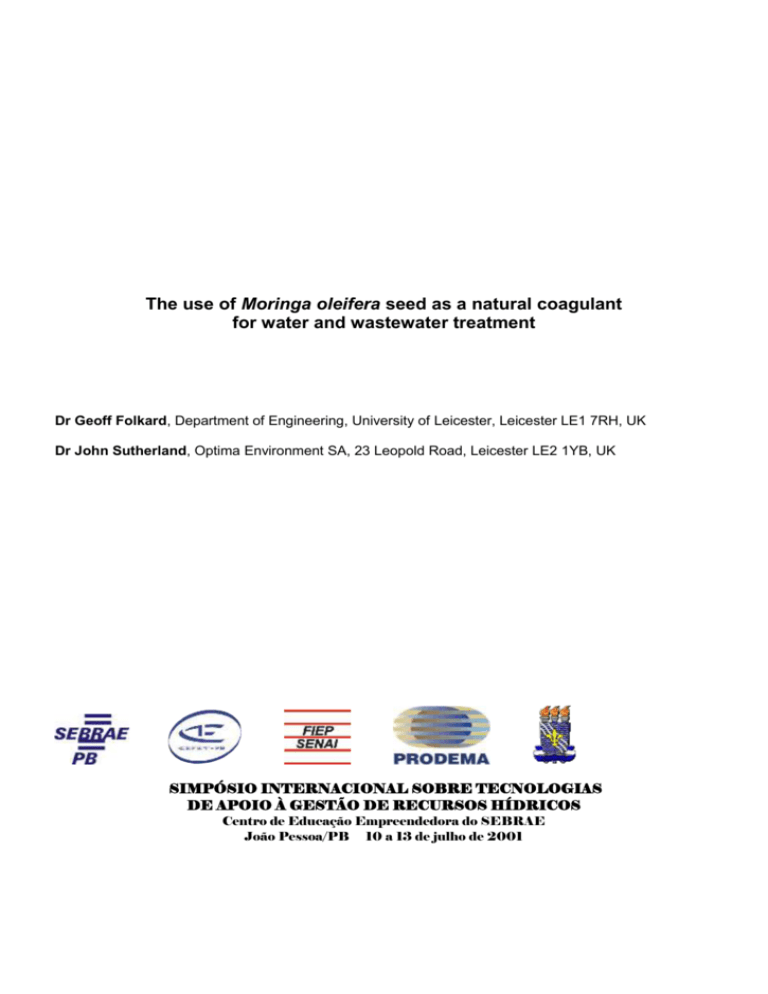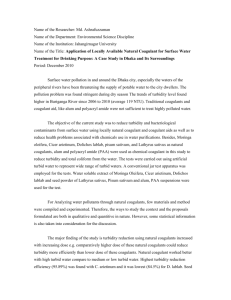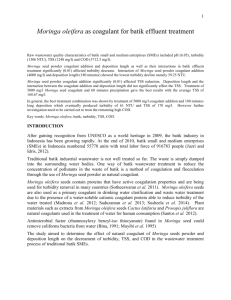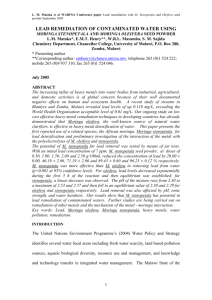The use of Moringa oleifera as a natural coagulant
advertisement

The use of Moringa oleifera seed as a natural coagulant for water and wastewater treatment Dr Geoff Folkard, Department of Engineering, University of Leicester, Leicester LE1 7RH, UK Dr John Sutherland, Optima Environment SA, 23 Leopold Road, Leicester LE2 1YB, UK SIMPÓSIO INTERNACIONAL SOBRE TECNOLOGIAS DE APOIO À GESTÃO DE RECURSOS HÍDRICOS Centro de Educação Empreendedora do SEBRAE João Pessoa/PB 10 a 13 de julho de 2001 Abstract Moringa oleifera Lam. (M.oleifera) is a multipurpose tree of considerable potential and its cultivation is currently being actively promoted in many developing countries. The various uses and products of the tree are given. Seeds of this pan tropical tree contain water soluble, positively charged proteins that act as an effective coagulant for water and wastewater treatment (molecular weight 13 kDa and isoelectric pH 10-11). The Environmental Engineering Group at Leicester University, UK have evaluated the potential of this plant derived material for a range of treatment applications in the laboratory and in the field using water soluble extracts of the crushed kernel and of presscake (solids residue remaining after oil extraction – the oil content of the seed is high as is the quality). Significant performance test results are presented. M.oleifera seed was applied to a pilot scale treatment system (gravel bed flocculation – plain sedimentation – sand filtration) as a primary coagulant to clarify an African river water in the wet season. The source water exhibited a relatively constant turbidity of 400 NTU over the test period. Over 90% turbidity removal was achieved in the sedimentation stage at a dosage of 100 mgL-1. The M.oleifera dose is expressed as equivalent seed kernel material. The filtrate turbidity was maintained well below 5 NTU. Subsequent trials were conducted on the same river water in an adjacent municipal works comprising upflow contact clarifiers and rapid gravity filters operating at 60 m3h-1. Treatment performance was comparable to that of using aluminium sulphate as coagulant. Inlet turbidities in the range 270-380 NTU were consistently reduced to below 3 NTU. A comprehensive study was undertaken with the same source water in the dry season to evaluate the potential of using M.oleifera coagulant within a contact flocculation-filtration (CFF) pilot plant rig. For the purposes of this paper, CFF is defined as the high rate filtration process for relatively low turbidity raw waters wherein the coagulant is dosed immediately prior to entry to the sand bed – essentially single stage treatment. Flocculation and subsequent deposition occurs entirely within the filter bed. A wide range of operating conditions was evaluated in order to establish the useful ‘working envelope’ for this process combination (filtration rates 5-20 mh-1, initial turbidities 20-50 NTU). The main results of this field study are summarised. As a coagulant within chemically enhanced primary sedimentation (CEPS) of a mixed domestic/industrial wastewater, M.oleifera dosed at 150 mgL-1 gave additional removals (compared to a plain sedimentation control) of 40% for biochemical oxygen demand (BOD) and chemical oxygen demand (COD) and in excess of 80% for suspended solids (SS). Subsequent laboratory work at the University of Ghent coupled an upflow anaerobic sludge blanket reactor (UASB) to CEPS. M.oleifera coagulant in the CEPS pre-treatment unit beneficially increased the ratio of soluble COD to volatile SS by a factor of 10 compared to plain sedimentation and 3 when dosing ferric chloride as coagulant. The UASB yielded more biogas and gave 71% removal of total COD at 2 hours hydraulic residence time. This compared with 54% removal of total COD at the same residence time when ferric chloride was used. Brief details of a further study at Ghent are given relating to the enhanced start up of a UASB reactor with the addition of a water extract of M.oleifera seed. Recent research work on the extraction and purification of the active components from within the seed kernel is reviewed. Extraction of the proteins using 1M sodium chloride solution gave enhanced coagulation at significantly reduced dosage compared to water extracted material (95% turbidity reduction at 4 ml L-1 compared to 78% at 32 ml L-1 for a prepared test water comprising kaolin in water at an initial turbidity 50 NTU). The dosage is expressed as volume of a 1% stock seed solution. Further purification was achieved using a multi-stage sequence of dialysis, delipidation and anion exchange. The prospects for the commercialisation of M.oleifera seed coagulant(s) are discussed. Introduction The M.oleifera tree is a native of Northern India, which now grows widely throughout the tropics. English vernacular names include drumstick (shape of the pods) and horseradish (taste of the roots). It may be propagated from seeds or cuttings, grows well even in poor soils requiring minimal horticultural attention and is able to survive long periods of drought. It grows rapidly -growth of up to 4 metres in height, flowering and fruiting were all observed within one year during trials near Nsanje in Southern Malawi Extended and multiple harvests in a single year are evident in many parts of the world. The many products and numerous uses of the tree are given in Table 1. VEGETABLE Green pods, leaves, flowers and roasted seeds are highly nutritious OIL Seeds contain 40 % vegetable oil by weight - may be used for cooking, soap manufacture, cosmetics base and as a lamp fuel COAGULANT Crushed seed used traditionally to clarify turbid waters at individual/household treatment level in the Sudan and Kenya Successfully used at pilot and full scale in conventional water treatment works in Malawi Applicable to the contact flocculation-filtration process for relatively low turbidity waters Presscake remaining after oil extraction also effective as a coagulant Potential for use as an aid to primary sedimentation of wastewaters Potential for use in upflow anaerobic sludge blanket reactors for wastewater treatment OTHER USES All parts of the plant are used in a variety of traditional medicines Presscake as a soil conditioner/fertiliser and potentially as animal/poultry feed supplement Green Ieaves as a fertiliser-mulch Leaf extract used a foliar spray to stimulate plant growth Powdered seed used in ointment to treat common bacterial skin infections. Trees grown as live fence posts and windbreaks Source of fuel wood following coppicing Provider of semi-shade within an intercropping system Wood pulp for paper making industry Planted for specific protective and soil melioration functions Table 1 The products and uses of the Moringa oleifera tree Moringa derived coagulants - general River water drawn for human consumption and general household use can be highly turbid particularly in the rainy season. River silt is churned into suspension and run off from fields and other surfaces carries solid material, bacteria and other microorganisms into the river. It is of paramount importance to remove as much of this suspended matter as possible prior to a disinfection stage and subsequent consumption. This can generally only be achieved by the addition of coagulants to the raw water, within a controlled treatment sequence. In many developing countries, proprietary chemical coagulants, such as aluminium sulphate and synthetic polyelectrolytes are either not available locally or are imported using foreign exchange. A viable alternative is the use of crushed seed of M.oleifera as a natural coagulant. The seed pods are allowed to dry naturally on the tree prior to harvesting. The mature seeds are readily removed from the pods, easily shelled and then may be crushed and sieved using traditional techniques such as those employed for the production of maize flour The crushed seed powder, when mixed with water, yields water soluble proteins that possess a net positive charge (molecular weight 13 kDa and isoelectric pH 10-11). Dosing solutions are generally prepared as 1-3% solutions and are filtered prior to application to the untreated water (Sutherland et al, 1990). Of particular note from Table 1 is that the seeds contain up to 40% by weight of oil. The fatty acid profile shows an oleic acid content of 73% confirming that the oil is similar to olive oil and thus of high edible quality and market value. Edible oils are an essential component of human nutritional requirements. In developing countries, a few, large-scale urban-based companies usually dominate the production and marketing of edible oils. Rural supplies of the finished products are erratic with increased prices due to additional transport costs. Bench scale testing at Leicester confirmed that the presscake (solids residue remaining after oil extraction) still contains the active, water-soluble proteins. Significantly, two potentially valuable products may be derived from the seed. Moringa derived coagulants offers several advantages over conventional coagulants such as aluminium sulphate: Activity is maintained over a wide range of influent pH values – no pH correction required Natural alkalinity of the raw water is unchanged following coagulation – no addition of alkalinity required Sludge production is greatly reduced and is essentially organic in nature with no aluminium residuals – sludge volumes are reduced by a factor of up to 5 (Ndabigengesere et al, 1998) River water treatment at pilot scale It is now regarded as axiomatic that both water and wastewater technology for developing countries must be no more complex than strictly necessary and be robust and inexpensive to install and maintain. A prototype treatment works was designed founded on this philosophy. The pilot plant was constructed within the grounds of the Thyolo Water Treatment Works, the works being controlled by the Ministry of Works and Supplies Water Department of the Malawi Government. The pilot plant is shown schematically in Figure 1. River water is pumped at 1 m3h-1 from the River Nswadzi to a header tank where the M.oleifera seed solution is introduced into the turbulent jet of incoming water and mixed hydraulically. An 18-minute flocculation period is provided within the upflow gravel bed flocculators prior to plain sedimentation. A rapid gravity filter removes any residual floc carried over from the sedimentation tank. (All the units were locally fabricated in sheet steel of gauge SWG 16). The system was successfully commissioned during the rainy season with the source river exhibiting turbidity levels in excess of 400 NTU throughout the study period. Figure 2 shows the pilot plant performance for one test conducted over a 7-hour period. At a dose of 100 mgL-1, raw water turbidity of 400 NTU was reduced to approximately 30 NTU in the outflow from the sedimentation tank. As the sand filter ’worked in’, the final turbidity was approaching 1 NTU when a regional power failure terminated the test. Figure 3 is a composite of all the tests performed over the study period. Solids removal within the plant was consistently above 90% following the gravel bed flocculation stage and plain horizontal flow sedimentation. Subsequent rapid gravity sand filtration gave final, treated water turbidity generally well below 5 NTU. M.oleifera seed dose ranged from 75-250 mgL-1 depending on the initial raw water turbidity (Folkard et al,1993). River water treatment at full scale During the following wet season the main ThyoIo works was operated using M.oleifera solution as coagulant. The works comprise upflow contact clarifiers followed by rapid gravity filters and chlorination. The clarifiers were in a state of some disrepair with the impeller drives and chemical feed pumps inoperative. Under normal operation, alum solution is introduced into the incoming flow of 60 m3h-1 by simple gravity feed. Comparable treatment performance with alum was achieved. This was the first time that M.oleifera had been successfully used as a primary coagulant at such a scale with the treated water entering supply (Sutherland et al, 1994). Figure 4 shows the data for a 7.5-hour test with the main works flow at 60 m3h-1 and the seed dose at 75 mgL-1. The inlet turbidity is over 325 NTU and the output from the filter consistently below 2 NTU M.oleifera seed for the full-scale trials was purchased from enthusiastic villagers in the Nsanje region. This was viewed as a temporary yet very welcome new source of cash income in what is a poor rural community of Southern Malawi. The tree is widely cultivated in this area, being highly prized as a source of fresh, green vegetable. M.oleifera coagulant within contact flocculation-filtration (CFF) A comprehensive study was undertaken to evaluate the potential of using M.oleifera coagulant within a contact flocculation-filtration (CFF) pilot plant rig. For the purposes of this paper, CFF is defined as the high rate filtration process for relatively low turbidity raw waters (< 50 NTU) wherein the coagulant is dosed immediately prior to entry to the sand bed. Flocculation and subsequent deposition occurs entirely within the filter bed. A wide range of operating conditions was evaluated in order to establish the useful ‘working envelope’ of operational parameters for this single stage process. Previous studies had shown that at the low turbidities of the River Nswadzi experienced in the dry season, the effectiveness of M.oleifera coagulant is reduced. Flocs that formed were small, compact and light giving reduced settling velocities. This is considered to be a result of the fundamental nature of the coagulation and flocculation involved. The relatively low molecular weight of the active proteins indicates that charge neutralisation and floc formation are brought about by the patch mechanism as opposed to the bridging mechanism (Gregory, 1977). The field installation of the pilot CFF rig is given schematically as Figure 5. Full experimental details are given elsewhere (McConnachie et al, 1999). For prevailing raw water turbidities of < 50 NTU the single stage treatment of CFF gives a consistent filtrate turbidity < 1 NTU for filtration rates up to 10 mh-1. Moreover, the M.oleifera seed dose required to achieve this is relatively low (< 25 mgL-1) and the filter run times are appropriate for effective plant operation. Figures 6 and 7 are the test data for an experimental run at a filtration rate of 5 mh-1. As can be seen from Figure 7, the majority of solids removal occurs within a bed depth of 190 mm i.e. the top third of the sand bed. The effect of increasing the filtration rate is shown in Figure 8. Treatment of eutrophic water Treatment studies were also conducted at bench scale using a eutrophic lake water serving the main treatment works to Harare, Zimbabwe (Sutherland et al, 1995). The impounded water contained much light organic matter in suspension due to high algal growth and exhibited relatively low turbidity throughout the year. As such, the water is problematic to treat consuming significant quantities of alum (as primary coagulant) and activated silica (as weighting agent). Alum floc carry over from the clarifiers causes "filter blinding" and the sludge from the clarifiers is voluminous, difficult to dewater and presents pollution problems on discharge to the receiving water M.oleifera in combination with sodium bentonite as weighting agent produced a final water quality equivalent to that produced using the conventional chemical coagulants The sludge was significantly more compact and represents a potentially useful output as a soil conditioner/fertiliser. M.oleifera coagulant for wastewater treatment applications As a coagulant within chemically enhanced primary sedimentation (CEPS) of a mixed domestic/industrial wastewater, M.oleifera dosed at 150 mg l-1 gave additional removals (compared to a plain sedimentation control) of 40% for biochemical oxygen demand (BOD) and chemical oxygen demand (COD) and in excess of 80% for suspended solids (SS) (Folkard et al, 1999) Subsequent laboratory work at the University of Ghent coupled an upflow anaerobic sludge blanket reactor (UASB) to CEPS (Kalogo et al, 2000). The UASB process relies on the propensity of anaerobic biomass to aggregate into dense flocs or granules over time Mixing is achieved by pumping influent wastewater from an entry at the base upwards through the sludge blanket. Figure 9 is a schematic representation of a UASB. Above the blanket, finer particles flocculate and in the upper settlement zones they settle back as sludge in the blanket. Thus, washout of biomass is prevented. The biogas, which has poor solubility in water, is separated at the top of the reactor. Domestic wastewater treatment in UASB reactors has proved particularly effective in tropical regions of the world. Effective removal of organic matter and suspended solids is evident at reduced excess sludge volume compared to aerobic treatment. The system is compact, requires minimal energy inputs and does not require support media normally associated with anaerobic systems (de Sousa et al, 1996) UASB is characterised by a very high mean cell retention time (MCRT) and a relatively low hydraulic retention time (HRT). M.oleifera coagulant in the CEPS pre-treatment unit beneficially increased the ratio of soluble COD to volatile SS by a factor of 10 compared to plain sedimentation and 3 when dosing ferric chloride as coagulant. The UASB yielded more biogas and gave 71% removal of total COD at 2 hours HRT. This compared with 54% removal of total COD at the same retention time when ferric chloride was used. The loading capacity of an anaerobic wastewater treatment system is essentially determined by the amount of active biomass retained in the reactor. Especially in UASB reactors, the microbial aggregates must combine two important characteristics, namely a high biodegradation activity and excellent settling properties, favoured by the formation of granular sludge particles. One of the main problems in the application of this treatment process so far has been the extensively long start-up periods needed for the development of granules (up to six months). In a subsequent study at the University of Ghent, a water extract of M.oleifera seeds was used to enhance the start-up of a self-inoculated UASB reactor treating raw domestic wastewater (Kalogo et al, 2001). Two reactors labelled ‘control’ and ‘test’ were started without special inoculums. Both reactors were fed continuously for 22 weeks with domestic wastewater with an average total COD of 320 mgL-1 and SS of 165 mgL-1. The reactors operated during the entire experimental period at 29°C and at a HRT of 4 h. The ‘test’ reactor received 2 mL of a 2.5% (w/v) M.oleifera seed stock solution per litre of influent wastewater. The ‘test’ reactor give the following enhanced performance advantages over the ‘control’; 1. 2. 3. 4. 5. Shortened the biological start-up period by 20% Increased the acidogenic and methanogenic activity by factors of 2.4 and 2.2 respectively Increased the specific biogas production by a factor of 1.6 Favoured fast growth of the sludge bed Allowed the aggregation of coccoid bacteria and growth of microbial nuclei - the precursors of anaerobic granulation. Extraction and purification of the coagulant-active components from M.oleifera seed Treating water with water extracts of M.oleifera seeds has one identified disadvantage. The coagulantinactive seed material that is also water-soluble leads to elevated dissolved organic material in the treated water (nitrates, orthophosphates etc.). If chlorination is adopted for final disinfection of the clarified water then the potential for the formation of disinfection by-products (DBP) is increased. DBPs such as chloroform are suspected carcinogens and are strictly regulated in Europe and the United States. Residual organic matter may also exert a chlorine demand at the treatment works and be utilised by microorganisms as substrate for re-growth in the distribution system. Therefore there has been much recent research work on the extraction and purification of only the coagulant-active proteins from within the seed kernel. Protein extraction and purification from M.oleifera seed has been reported at laboratory scale only. The aim of these studies was to secure only a few milligrams of pure protein for the characterisation of coagulant activity and structure. Extraction of the proteins using 1M sodium chloride solution gave enhanced coagulation at significantly reduced dosage compared to water extracted material - 95% turbidity reduction at 4 ml L-1 compared to 78% reduction at 32 ml L-1 for a prepared test water comprising kaolin in water of initial turbidity 50 NTU (the dosage being expressed as volume of 1% stock seed solution, Okuda et al, 1999). The improvement in extraction is attributed to the ‘salting-in’ mechanism whereby increased ionic strength gives increased protein solubility. The extraction of seed proteins in other salts gave similar improvements. Purification of the active components was achieved by the same research group using the following sequence of stages (Okuda et al, 2001); 1. 2. 3. 4. 5. 6. 7. 8. Extraction of the seed material in 1M NaCl solution Dialysis with molecular cut off 12-14 kDa (precipitate forms by the ‘salting out’ mechanism) Centrifugation to recover the precipitate Precipitate washed with deionised water Removal of lipids by homogenisation in cold acetone Recovery of precipitate by centrifugation followed by rinsing with cold acetone Precipitate dissolved in ammonium buffer and centrifuged to remove insoluble matter Pass solution through an anion exchange column and elute with NaCl solution The purified material was deemed to be an organic polyelectrolyte of molecular weight around 3 kDa - but not to be a protein, polysaccharide or lipid. The authors claim that the ‘specific coagulation efficiency’ of this active material is up to 34 times more than that of a water extract of seed, that it is effective for low turbidity waters and that no increase in residual organic carbon is evident following application. There are many unresolved issues relating to the commercial viability of the scale-up of protein separation including; Technical feasibility/applicability of the scale-up of laboratory unit processes that comprises the sequence of separation Cost of production and the overall economics from cultivation, seed purchase, harvesting, oil extraction and sales, development of various commercial markets etc. Final desired form of the protein products – concentrated solutions / dried products Stability of protein products in storage Ease of preparation of dosing solutions for treatment applications Quality control and acceptable levels of impurities Regulatory aspects Conclusions Promotion and development of M.oleifera as a natural coagulant offers many diverse advantages to many countries of the developing world; sustainable, appropriate, effective and robust water treatment, effective enhancement of particular wastewater treatment processes, decreased reliance on the importation and distribution of treatment chemicals, the creation of a new cash crop for farmers and employment opportunities. Many technical and economic issues remain to be resolved with regard to the extraction and purification of the active components within the seed kernel. References De Sousa, J.T. & Foresti, E. 1996, Domestic sewage treatment in an upflow anaerobic sludge blanket – sequencing batch reactor system, Water Science & Technology, 33, 3, pp 73-84. Folkard, G.K. Sutherland, J.P. & Grant, W.D. 1993, Natural coagulants at pilot scale; In Pickford, J. ed Water, Environment and Management; Proc 18th WEDC Conference, Kathmandu, Nepal, 30 Aug-3 Sept 1992, Loughborough University Press, pp 51-54. Folkard, G.K., Sutherland, J.P. & Shaw, R. 1999, Water clarification using Moringa oleifera seed coagulant. In; Shaw, R. (ed), Running Water. Pub: Intermediate Technology Publications, London, ISBN 1-85339-450-5, pp 109-112. Kalogo, Y. & Verstraete, W. 2000, Technical feasibility of the treatment of domestic wastewater by a CEPS-UASB system, Environmental Technology, 21, pp 55-65. Kalogo, Y., M’Bassiguie Seka, A. & Verstraete, W. 2001, Enhancing the start-up of a UASB reactor treating domestic wastewater by adding a water extract of Moringa oleifera seeds. Centre for Environmental Sanitation, LabMET, University of Ghent, in press. McConnachie, G.L., Folkard, G.K., Mtawali, M.A. & Sutherland, J.P. 1999, Field trials of appropriate hydraulic flocculation processes, Water Research, 33, 6, 1425-1434. Ndabigengesere, A. & Narasiah, K.S. 1998, Quality of water treated by coagulation using Moringa oleifera seed, Water Research, 32 , 3, pp 781-791. Okuda, T., Baes, A.U., Nishijima, W. & Okada, M. 1999, Improvement of extraction method of coagulation active components from Moringa oleifera seed, Water Research, 33, 15, pp 3373-3378. Okuda, T., Baes, A.U., Nishijima, W. & Okada, M. 2001, Isolation and characterisation of coagulant extracted from Moringa oleifera seed by salt solution, Water Research, 35, 2, pp 405-410. Sutherland, J. P. 1993, Oil and coagulant extraction from M.oleifera seed, Draft Report to the ODA, London, September 1993. Sutherland, J.P., Folkard, G.K. & AI Khalili, R.S. 1995, Preliminary investigations of alternative coagulant - flocculant dosing regimes to treat the Morton Jaffray source water, Report to Construction Associates (PVT), Harare, May 1995. Sutherland, J.P., Folkard, G.K. & Grant, W.D. 1990, Natural coagulants for appropriate water treatment a novel approach, Waterlines, April, 8, (4), pp 30-32.










